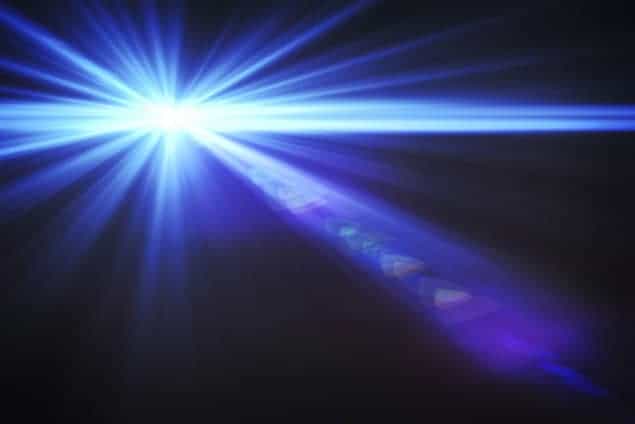
The speed of light in a vacuum is 299,792,458 m s–1, right? Not necessarily, according to a team of physicists in the UK, which has found that the speed of an individual photon decreases by a tiny amount if it is initially sent through a patterned mask. The phenomenon – which is different to other observations of slow light – should also occur for sound waves, the researchers say.
The speed of light has been measured since as far back as the 17th century, but it was not until the 1970s that physicists settled on a value that was accurate in a vacuum to just a few parts per billion. In 1983 that value became the official value, fixed against a new definition of the metre in the International System of Units. And an important value it is, for according to Einstein’s special theory of relativity, the speed of light in a vacuum, c, is the maximum speed obtainable by any entity – no matter what inertial frame of reference it is measured in.
Of course, light can appear to slow down if it travels through a dense medium – a result of the photons having to interact with the medium and take an indirect route through it. In water, the speed of light is roughly 225,000,000 m s–1, while in glass it is roughly 200,000,000 m s–1. The change can be even more drastic – particularly in highly “nonlinear” materials, in which light’s speed can be reduced to just a few metres per second. Strange effects can also occur in a vacuum, including the Gouy phase shift, which happens when a beam of light is focused to a point and results in a tiny increase in its “phase velocity”.
Structured photons
Now it seems that physicists have come up with a new way of changing the speed of light in a vacuum. Over two years, Miles Padgett and colleagues at the University of Glasgow, together with Daniele Faccio of Heriot-Watt University in Edinburgh, designed an experiment that can determine whether light with a certain “spatial structure” travels substantially slower than regular light in a vacuum. The researchers created a source that emitted pairs of photons simultaneously. One of the photons went straight to a highly precise photon counter, while the other went via two liquid-crystal masks, which imparted their profile onto the passing particle of light.
Across a propagation distance of 1 m, the team found that the spatially structured photon lagged behind its partner by between 10 and 20 wavelengths. That equated to a drop in speed of about 0.001%, says team member Jacquiline Romero.
There are many ways of defining the speed of light: phase velocity, peak velocity, information velocity – definitions abound. Padgett and colleagues stick to the group velocity, which is a measure of how fast the envelope of an electromagnetic wave moves. When a beam of light passes through a mask, some of its constituent rays will continue to propagate at a slight angle to the beam’s axis. These rays have to travel farther, therefore the group velocity of the entire envelope falls – and this is what the researchers observed.
No ambiguities?
The reliance on group velocity might seem like an important footnote, but the researchers believe that the use of single photons in their experiment should remove any ambiguities in interpretation. “One of the nice things about our work is that we have taken the simple case of single photons, which when observed make a detector go ‘click’,” says Padgett.
Padgett does not know what, if any, applications could result from the findings. The effect is biggest, he explains, when the diameter of the optics used is large and the distances are short, so it is unlikely to have any impact in astronomy. Nonetheless, he believes the phenomenon should exist in any wave, including sound. “We did this experiment really to satisfy our own curiosity,” he explains. “We have always been interested in structured beams.”
Goëry Genty, a physicist at the Tampere University of Technology in Finland says that the experiment is interesting because it measures the group velocity of photons. “In that sense, the results are not in contradiction with anything we know from textbooks, and certainly not with special relativity,” he adds. “There have been couple of experiments in the past to show this effect, but perhaps here the novelty lies in the fact that the researchers are dealing with single photons.”
The research is published in Science.
- Check out our free-to-read digital edition of Physics World magazine containing 10 of our best-ever features on the science and applications of light, which we have put together to mark the International Year of Light



